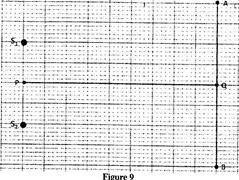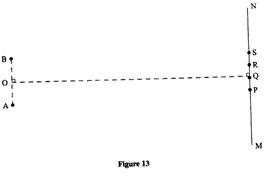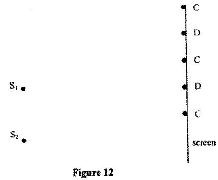Total capacitance = 3×33+3 = 1.5
= 1.5 x 10-6F
Q = CV = 1.5 x 10-6 x 3 = 4.5 x 10-6C
johnmulu answered the question on May 26, 2017 at 12:38
- Figure 7 shows a sharp pin fixed on a cap of leaf electroscope. The electroscope is highly charged and then left for some time. (Solved)
Figure 7 shows a sharp pin fixed on a cap of leaf electroscope. The electroscope is highly charged and then left for some time.

Explain why the leaf collapses.
Date posted: May 26, 2017. Answers (1)
- Fig 5 shows a circuit for changing and discharging a capacitor, c, through a variable resistor R. X, Y and T are points on a two-way switch. (Solved)
Fig 5 shows a circuit for changing and discharging a capacitor, c, through a variable resistor R. X, Y and T are points on a two-way switch.

Explain how the charging and discharging processes are achieved.
Date posted: May 26, 2017. Answers (1)
- Figure 8 represents two parallel plates of a capacitor separated by a distance d. Each plate has an area of A square units. (Solved)
Figure 8 represents two parallel plates of a capacitor separated by a distance d. Each plate has an area of A square units.

Suggest two adjustments that can be made so as to reduce the effective capacitance.
Date posted: May 26, 2017. Answers (1)
- Figure 9 shows two speakers S1 and S2 which produce sound of the same frequency. They are placed equidistant from a line AB and a line PQ. (PQ is perpendicular to line AB).(Solved)
Figure 9 shows two speakers S1 and S2 which produce sound of the same frequency. They are placed equidistant from a line AB and a line PQ. (PQ is perpendicular to line AB).

(i) A student walking from A and B hears alternating loud and soft sounds. Explain why at some point the sound heard is soft.
(ii) The student now walks along line PQ. State with reason the nature of the sound the student hears.
Date posted: May 26, 2017. Answers (1)
- Figure 13 shows two identical dippers A and B vibrating in water in phase with each other. The dippers have the same constant frequency and amplitude. The waves produced are observed along line MN:(Solved)
Figure 13 shows two identical dippers A and B vibrating in water in phase with each other. The dippers have the same constant frequency and amplitude. The waves produced are observed along line MN:

It is observed that the amplitude are maximum at points P and R.
(i) Explain why the amplitude is maximum at Q.
(ii) State why the amplitude is minimum at R.
(iii) State what would happen if the two dippers had different frequencies.
Date posted: May 26, 2017. Answers (1)
- Figure 12 shows a set up for observing interference of waves from two sources S1 and S2. The points C and D represent positions of the constructive and destructive interference respectively as observed on the screen. (Solved)
Figure 12 shows a set up for observing interference of waves from two sources S1 and S2. The points C and D represent positions of the constructive and destructive interference respectively as observed on the screen.


(a) If the observation was made in a ripple tank, describe:
(i) How the two sets of coherent waves were produced;
(ii) How the constructive and destructive interference are identified.
(b) Explain how the constructive interference C and the destructive interference D patterns are produced.
Date posted: May 26, 2017. Answers (1)
- Figure 15 shows an experiment arrangement for determining the wavelength of light, (Solved)
Figure 15 shows an experiment arrangement for determining the wavelength of light,

State and explain the difference in the patterns observed on the screen other than the difference in colour when the source of red light is replaced by a source of violet light.
Date posted: May 26, 2017. Answers (1)
- Fig. 6.1 shows the cross-section of a ripple tank full of water. A piece of cork floats on the surface of the water as shown.(Solved)
Fig. 6.1 shows the cross-section of a ripple tank full of water. A piece of cork floats on the surface of the water as shown. Fig.6 II shows the water surface viewed from above. A straight edge vibrator placed at the end A of ripple tank generates water waves, which travel towards end B as shown.

(i) Identify the type of waves generated in the water surface.
(ii) It is observed that as the waves pass the cork every 0.20 seconds. If the speed of the waves is 0.30ms-1, determine the frequency and wavelength of the waves at that point.
Date posted: May 26, 2017. Answers (1)
- In the Young's double slit experiment, and interference pattern of bright and dark fridges was formed as shown in Figure 1 by a light of wavelength coming from two narrow slits X and Y.(Solved)
In the Young's double slit experiment, and interference pattern of bright and dark fridges was formed as shown in Figure 1 by a light of wavelength coming from two narrow slits X and Y.
 (i) Explain how the dark and bright fringes are formed.
(i) Explain how the dark and bright fringes are formed.
(ii) State and explain what would be observed on the screen if the slits X and Y were made large.
Date posted: May 26, 2017. Answers (1)
- In the Young's double slit experiment, and interference pattern of bright and dark fridges was formed as shown in Figure 1 by a light of wavelength coming from two narrow slits X and Y.(Solved)
In the Young's double slit experiment, and interference pattern of bright and dark fridges was formed as shown in Figure 1 by a light of wavelength coming from two narrow slits X and Y.

(i) Explain how the dark and bright fringes are formed.
(ii) State and explain what would be observed on the screen if the slits X and Y were made large.
Date posted: May 26, 2017. Answers (1)
- Fig. 11 shows a double slit placed in front of a source, S, of waves. A director D is placed beyond the slits, such that its position can be adjusted along the line XY. (Solved)
Fig. 11 shows a double slit placed in front of a source, S, of waves. A director D is placed beyond the slits, such that its position can be adjusted along the line XY.

State with a reason, what the detector records along XY.
Date posted: May 26, 2017. Answers (1)
- Figure 7 shows two lond speakers L1 and L2 connected to a signal generator
(Solved)
Figure 7 shows two lond speakers L1 and L2 connected to a signal generator

One observer walks along line OO' and another line AA' for some distance. Describe the observations made by each observer and give reasons for your answer.
Date posted: May 26, 2017. Answers (1)
- Figure 12 shows an experimental arrangement. S1, S2 and S are narrow slits.(Solved)
Figure 12 shows an experimental arrangement. S1, S2 and S are narrow slits.

State what is observed on the screen when the source is?
(a) monochromatic
(b) white light.
Date posted: May 26, 2017. Answers (1)
- In an experiment to observe interference of light waves a double slit is placed close to the source. See Fig. 3(Solved)
In an experiment to observe interference of light waves a double slit is placed close to the source. See Fig. 3

(i) State the function of the double slit.
(ii) Describe what is observed on the screen.
Date posted: May 26, 2017. Answers (1)
- Circular water waves generated by a point sources at the centre, O, of the pond are observed to have the pattern shown in Figure 6
(Solved)
Circular water waves generated by a point sources at the centre, O, of the pond are observed to have the pattern shown in Figure 6

Explain the pattern.
Date posted: May 26, 2017. Answers (1)
- Figure 7 shows resistors R1 and R2 connected in parallel. Their ends are connected to a battery of potential difference V volts. (Solved)
Figure 7 shows resistors R1 and R2 connected in parallel. Their ends are connected to a battery of potential difference V volts.

In terms of V1, R1 and R2, write an expression for:
(i) Current I1 through R1
(ii) Current I2 through R2
(iii) Total current I in the circuit.
Date posted: May 26, 2017. Answers (1)
- Figure 1 shows a cell of e.m.f 2 V connected in series with a resistor R and a switch S. Voltmeter V1 and V2 are connected across the cell and the resistor respectively. (Solved)
Figure 1 shows a cell of e.m.f 2 V connected in series with a resistor R and a switch S. Voltmeter V1 and V2 are connected across the cell and the resistor respectively.

(a) State the reading of V1 with S open.
(b) With S closed, V1 reads 1.6V. State the reading of V2.
Date posted: May 26, 2017. Answers (1)
- Figure 14 shows a circuit in which a battery, a switch, a bulb, a resistor P, a variable resistor(Solved)
Figure 14 shows a circuit in which a battery, a switch, a bulb, a resistor P, a variable resistor C a voltmeter V and two ammeters A and A of negligible resistance are connected. P has resistance of 10 ohms. When the switch is closed a reads 1.5 V.

Determine;
(i) The current passing through P;
(ii) The resistance of the bulb.
Date posted: May 23, 2017. Answers (1)
- Figure 3 shows four identical light bulbs connected to a volt battery whose internal resistance is negligible.(Solved)
Figure 3 shows four identical light bulbs connected to a volt battery whose internal resistance is negligible.

Determine the reading of the voltmeter V.
Date posted: May 23, 2017. Answers (1)
- Figure 8, shows a shows a graph of potential difference V (volts) against a current I (amperes) for a certain device. (Solved)
Figure 8, shows a shows a graph of potential difference V (volts) against a current I (amperes) for a certain device.

From the graph:
(i) State with a reason whether or not the device obeys ohms law.
(ii) Determine the resistance of the device at;
(I) I = 1.5 A
(II) I = 3.5 A
Date posted: May 23, 2017. Answers (1)